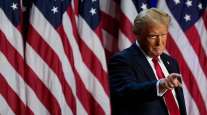US, China Crafting Foundation for Trade Deal, Source Says

U.S. and Chinese negotiators are working on multiple memorandums of understanding that would form the basis of a final trade deal, according to a person briefed on the talks.
The MoUs would cover areas including agriculture, nontariff barriers, services, technology transfer and intellectual property, said the person, who asked not to be identified because the discussions are private. The enforcement mechanism remains unclear but would likely be a threat that tariffs would be reimposed if conditions aren’t met, the person said.
No breakthrough is expected during this week’s talks in Washington on major structural issues, the person said, but there is an effort underway to potentially extend a March 1 deadline for U.S. tariffs to rise on Chinese goods. Liu He, China’s chief negotiator, is expected to meet with President Donald Trump on Feb. 22, according to a separate person familiar with the situation.
The United States also is asking China to keep the value of the yuan stable to neutralize any effort by Beijing to devalue its currency to counter U.S. tariffs, according to other people familiar with the ongoing talks. The Chinese government spokesman said Feb. 20 that the nation wouldn’t use the yuan as a tool to deal with trade dispute.

China Vice Premier and chief negotiator Liu He. (Al Drago/Bloomberg News)
Gao Feng, spokesman for China’s Ministry of Commerce, said at a briefing Feb. 21 that he had no details regarding any MoU being discussed with the United States. He also said that he couldn’t offer any information on the results of the trade talks until the current round ends.
A spokesman for the U.S. Trade Representative didn’t immediately respond to a request for comment. Reuters earlier reported that U.S. and Chinese officials were discussing language on six memorandums of understanding that would resolve the trade war’s most contentious issues.
While Trump has been most vocal on bilateral trade deficit with China, the United States has numerous issues with China’s economic and trade policies, and the administration is pushing for what it terms “fair and reciprocal” trade.
In response, China repeatedly has offered to increase purchases of agricultural and energy products to shrink the deficit. Since the tariff truce agreed to in December, it has resumed imports of some farm products and a deal may see a substantial increase in that trade.




